BEA Point to Inadequate Maintenance Data and Possible Non-Conforming Fasteners in ATR 42 Door Loss (Hop! ATR 42-500F-GPYF)
On 25 March 2018 ATR 42-500 F-GPYF of HOP! flew from Paris-Orly to Aurillac. At top of descent the 15 kg left Main Landing Gear (MLG) door separated from the aircraft, impacting and damaging the left-hand wing/body fairing. The aircraft was able to make a safe landing.
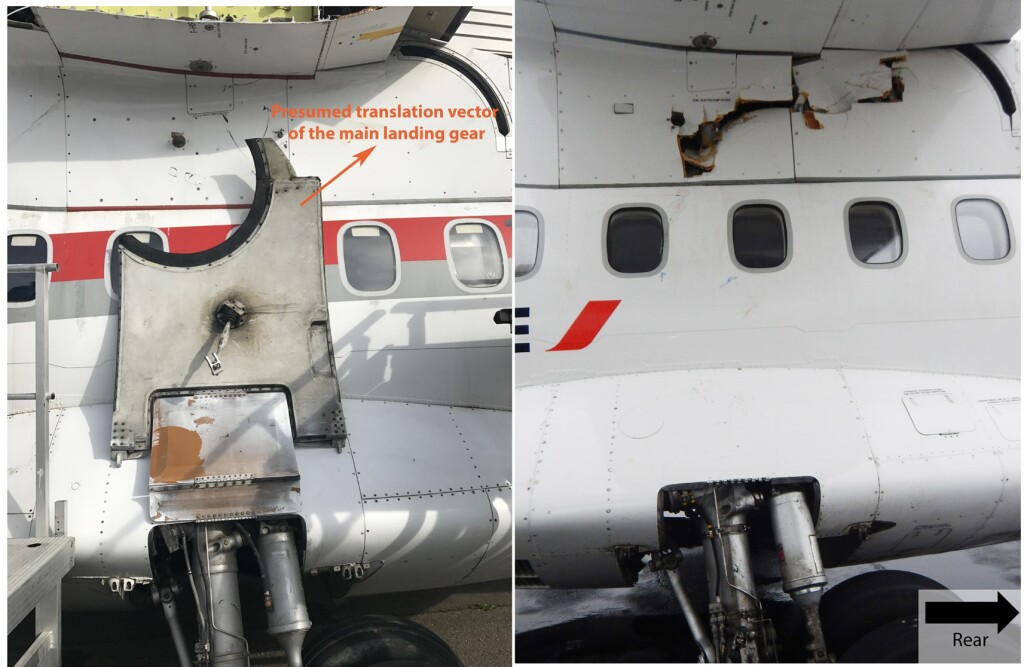
Hop! ATR 42-500 F-GPYF: Comparison of Damage (right) with a Test on ATR42 MSN002 (left) (Credit: ATR via BEA)
The Accident
The French Bureau d’Enquêtes et d’Analyses pour la Sécurité de l’Aviation Civile (the BEA) explain in their safety investigation report (issued in February 2021) that examination…
…of the aeroplane’s left MLG door made it possible to establish that the nut of the door’s rear hinge assembly had unscrewed in service before coming off.
The screw then moved backwards which allowed the male hinge to come out of the female hinge resulting in the landing gear door being slightly misaligned with the fuselage.
This misalignment increased the aeroplane’s drag.
The analysis of the FDR data found that the increased drag and thus the misalignment of the door was present at least from the first level flight at FL110 and that it probably did not exist on the previous flights.
This abnormal position of the door also resulted in additional loads on the other landing gear door attachment points, in particular the link which failed under fatigue at the start of the descent.
The loss of the link and rear hinge assembly attachment points then introduced substantial loads on the remaining main attachment point, the front hinge assembly, until failure under overload of the male hinge.
Once the three main attachment points were no longer effective (link, front hinge assembly and rear hinge assembly), the door swung upwards around hinge No. 1 and struck the fuselage and window. This situation generated the noise heard and jolt felt by people on the plane followed by the failure under overload of this same hinge.
The door then separated causing:
- damage to wing root fairings
- scratches to a cabin window and the surrounding skin
- a tear on the lower surface skin of the left flap
- scratches on lower surface skin of the left wing
- small dents on vertical stabilizer.
The BEA note that:
An occurrence in 2013 reported by ATR showed significant similarities… [M]aintenance had been performed on the landing gear doors shortly before the occurrence and that the job card had only been partially applied because of a shift change while the task was being performed. This could have resulted in some of the nuts on the landing gear door hinge assemblies not being tightened.
Although the hinge assemblies of the main landing gear doors are not considered as critical parts, these two occurrences show that the simple loss of the nut from the rear hinge assembly can result in the loss of a main landing gear door weighing around 15 kg leading to risks for the aeroplane and also constituting a danger for people and infrastructures on the ground which cannot be ignored.
There is sadly often over-enthusiasm for assuming maintenance errors have occurred due to a ‘Failure to Follow Procedures” (FFP), obsessing on classifying how and why personnel ‘violated’ those procedures and applying crude culpability decision aids. This case study shows that approach is very misguided in limiting the potential for holistic systemic improvement.
Fortunately, the “sole objective” of BEA safety investigations aims “at improving aviation safety [and] does not presuppose the existence of a misdemeanour or a crime”. This investigation therefore did not fall for the biases that can occur in relation to procedures.
Factors That Could Lead to Loss of the Nut
The BEA explain that…
…given the analysis of the manufacturer’s maintenance documentation, the results of the inspection of the operator’s fleet and the examination of the three other F-GPYF nuts which were recovered (nut from the front hinge assembly of the left main landing gear door and nuts from both the front and rear hinge assemblies of the right main landing gear door), the investigation brought to light several factors which, individually or together, might have potentially contributed to the unscrewing of the nut.
The mechanical performance of a screwed joint depends on multiple parameters defined during the initial design. The change of one of these parameters may compromise the design. However, the actual impact…could not be quantified…
First, the investigators considered the design of the nut:
Examination of the fasteners of the HOP! ATR 42 fleet found that around 50% of the nuts (and in particular the three nuts from the hinge assemblies of the left and right main landing gear doors of F-GPYF which were recovered) did not correspond to the material specified by ATR during the initial design of the assembly.
During the investigation, it emerged that there were differences between the configuration specified by ATR during the initial design of the hinge assemblies of the main landing gear doors and the alternatives authorized by the maintenance documentation. In fact, errors in transcribing standards and/or the omission of information in various documents (SRM, AMM, SPET), meant that it was possible to choose unsuitable alternative P/Ns.
The nut whose loss triggered the occurrence was not recovered and the BEA were unable to determine when it was installed or which P/N it was, however…
The hypothesis of an unsuitable nut cannot, however, be excluded given the number of unsuitable nuts on the rest of the HOP! ATR 42 fleet and the characteristics of the three remaining nuts on F-GPYF.
Secondly, in relation to the application of tightening torque, this…
…is an important factor in the mechanical performance of a screwed joint. It must be sufficient to guarantee that the fastener is correctly secured with respect to the loads applied to the system without, however, exceeding the mechanical characteristics of one of the assembly components.
At the date of the occurrence, the tightening torque was not available on the job card…for the installation of the gear doors. It was thus necessary to search for this information in the manufacturer’s generic documentation (in particular in the AMM and SRM).
However…
Information to determine the tightening torque to be applied based on this generic documentation was missing. In addition, there were errors in the documentation in question.
Interviews carried out with the mechanics in the Part-145 HOP! and RAS [Hop! supplier Rheinland Air Service] maintenance organisations revealed that these assemblies were not identified as being critical. In addition, given that the tightening torque was not indicated in the job card, few mechanics had looked for the tightening torque to be applied in the ATR documentation. In practice, they generally tightened the nuts by 45°.
The tightening torque information that ATR supplied to the operator for the inspection of the HOP! fleet, compared to the values indicated in the job card updated after the occurrence, also showed inconsistencies in the tightening torques to be applied to these assemblies.
The minimum tightening torque values required by ATR following the modification of the job card are the same as the nut’s maximum self-locking torque authorized by the procurement specification NASM25027 (90 in.lbf for the front hinge assembly and 60 in.lbf for the rear hinge assembly).
The BEA conclude that…
…given the complexity of the documentation, the perception of the assemblies as having a low criticality level, and the discrepancy between the possible tightening torque ranges, it is probable that an unsuitable tightening torque was applied to the nut of the left rear hinge assembly on F-GPYF.
Thirdly, BEA considered in the nut itself was defective. This might occur due to production defects:
As indicated by EASA in its document CARI 20-01 ([reproduced in Appendix 6 of the BEA report], certain batches of procured nuts complying with the standards NASM21042, MS21042 and NAS1291 can have defects which can lead to their failure.
[I]t cannot be excluded that the three remaining nuts of the hinge assemblies of the main landing gear doors on F-GPYF corresponded to standards NAS1291 or MS21042.
EASA subsequently published Safety Information Bulletin: 2012-06: Defective Standard Hardware – MS21042, NAS1291 and LN9338 Self-Locking Nuts, and NAS626 Bolts.
Alternatively it could occur due to reuse of these self-locking nuts:
The purpose of the self-locking function, a mechanical safety device chosen by ATR for these fasteners, is to impede the nut from unscrewing under transverse loads to the screw’s axis and/or vibrations. Each time this type of nut is used, the self-locking torque decreases with the number of tightening/untightening operations.
At the time of the occurrence, the ATR documentation did not include any specific indication about checking the self-locking capability before reusing this type of nut. It could be reused if it met the visual inspection criteria applicable to all nuts, but a failure of the self-locking function cannot generally be detected by this type of inspection.
Inspection of the Hinge
On the detection of an unsuitable nut:
[T]he fairings protecting the hinge assemblies of the landing gear doors had to be removed in order to be able to check the nuts. However, even when the fairings are removed, it is still difficult to determine if the nut in place is the one wanted, due, in particular, to the absence of any marking on the nut. Thus, once an unsuitable nut is installed on the plane, it becomes very difficult to detect the error during later operations.
On the detection of nuts unscrewing:
Partial loosening or unscrewing of the nut does not result in the immediate loss of the hinge assembly’s functionality (pivot link to open and close the door), this can in fact occur several years later as the incident to F-GPYF shows. Conversely, once the nut has been lost, the door may separate from the aeroplane in the relatively short time of a few flights.
At the time of the occurrence, only the removal of the fairings during maintenance operations would allow an agent to see whether the hinge fastener was loose. The frequency of these operations (in particular, every nine years or 20,000 landings for the removal of the landing gear) and the perception of their criticality meant that the possible progressive loosening of the nut on F-GPYF was not detected.
BEA Conclusions
The following combinations of organisational factors and human factors may have contributed:
- The ATR maintenance documentation concerning the choice of nuts to be used as an alternative to the IPC P/Ns was complex and contained errors which could lead to the choice of a nut with an unsuitable P/N.
- The tightening torque to be applied to this fastener and to the associated alternatives was missing from the ATR documentation.
- The ATR generic maintenance documentation allowed nuts to be reused without checking their self-locking capability. The landing gear door removal/installation job card did not specify that it was a self-locking nut and did not require a check for its self-locking capability or its replacement with a new nut.
BEA Safety Recommendations
- FRAN 2021-001: ATR ensure, with respect to standard parts with nuts, that there is no ambiguity in the documents about the choice of P/N and its alternatives, along with the tightening torque to be applied.
- FRAN 2021-002: ATR define a policy for reusing self-locking nuts and ensure that the information about the presence of self-locking nuts can be easily found by the maintenance operator.
Safety Resources
You might find these safety / human factors resources of use:
- James Reason’s 12 Principles of Error Management
- Back to the Future: Error Management
- This 2006 review of the book Resilience Engineering by Hollnagel, Woods and Leveson, presented to the RAeS by Aerossurance’s Andy Evans: Resilience Engineering – A Review and this book review of Dekker’s The Field Guide to Understanding Human Error: The Field Guide to Understanding Human Error – A Review.
You may also find these Aerossurance articles of interest:
- B1900D Emergency Landing: Maintenance Standards & Practices
- When Down Is Up: 747 Actuator Installation Incident – another case where a large component was released at altitude
- Flybe Fume Event (Part 1): Compressor Wash Maintenance Human Factors Case Study
- ERJ-190 Flying Control Rigging Error
- Luftwaffe VVIP Global 5000 Written Off After Flying Control Assembly Error
- C-130 Fireball Due to Modification Error
- Fatal $16 Million Maintenance Errors
- Engine Shutdown Results in Revised SOV Rigging Instructions
- SAR AS365N3 Flying Control Disconnect: BFU Investigation
- ‘Crazy’ KC-10 Boom Loss: Informal Maintenance Shift Handovers and Skipped Tasks
- Maintenance Issues in Fire-Fighting S-61A Accident
- United Airways Suffers from ED (Error Dysfunction)
- NTSB Confirms United Airlines Maintenance Error After 12 Years
- USAF RC-135V Rivet Joint Oxygen Fire
- ATR72 VH-FVR Missed Damage: Maintenance Lessons
- The Missing Igniters: Fatigue & Management of Change Shortcomings
- A319 Double Cowling Loss and Fire – AAIB Report
- B747 Landing Gear Failure Due to Omission of Rig Pin During Maintenance
- Maintenance Human Factors in Finnish F406 Landing Gear Collapse
- Hoist Assembly Errors: SAR Personnel Dropped Into Sea
- Crossed Cables: Colgan Air B1900D N240CJ Maintenance Error
- A Lufthansa MD-11F Nose Wheel Detached after Maintenance Error
- Inadequate Maintenance, An Engine Failure and Mishandling: Crash of a USAF WC-130H
- UPDATE 15 March 2021: ATR 72 Rudder Travel Limitation Unit Incident: Latent Potential for Misassembly Meets Commercial Pressure
- UPDATE 25 March 2023: Managing Interruptions: HEMS Call-Out During Engine Rinse
- UPDATE 29 July 2023: Missing Cotter Pin Causes Fatal S-61N Accident

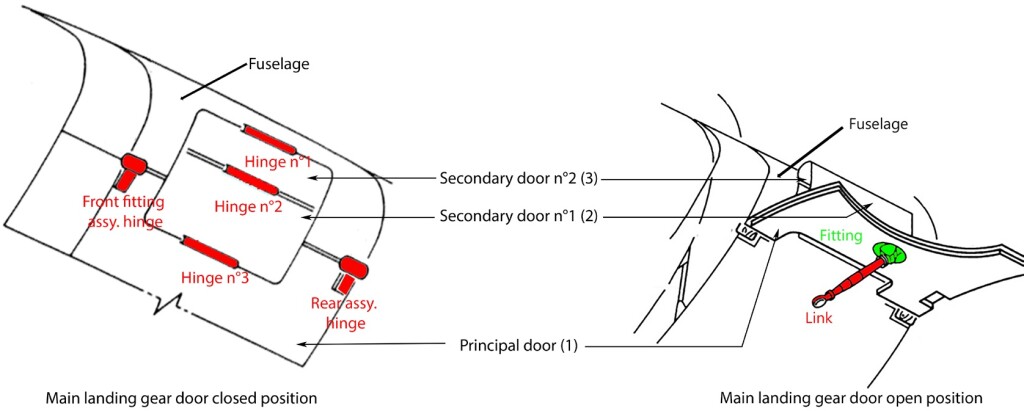

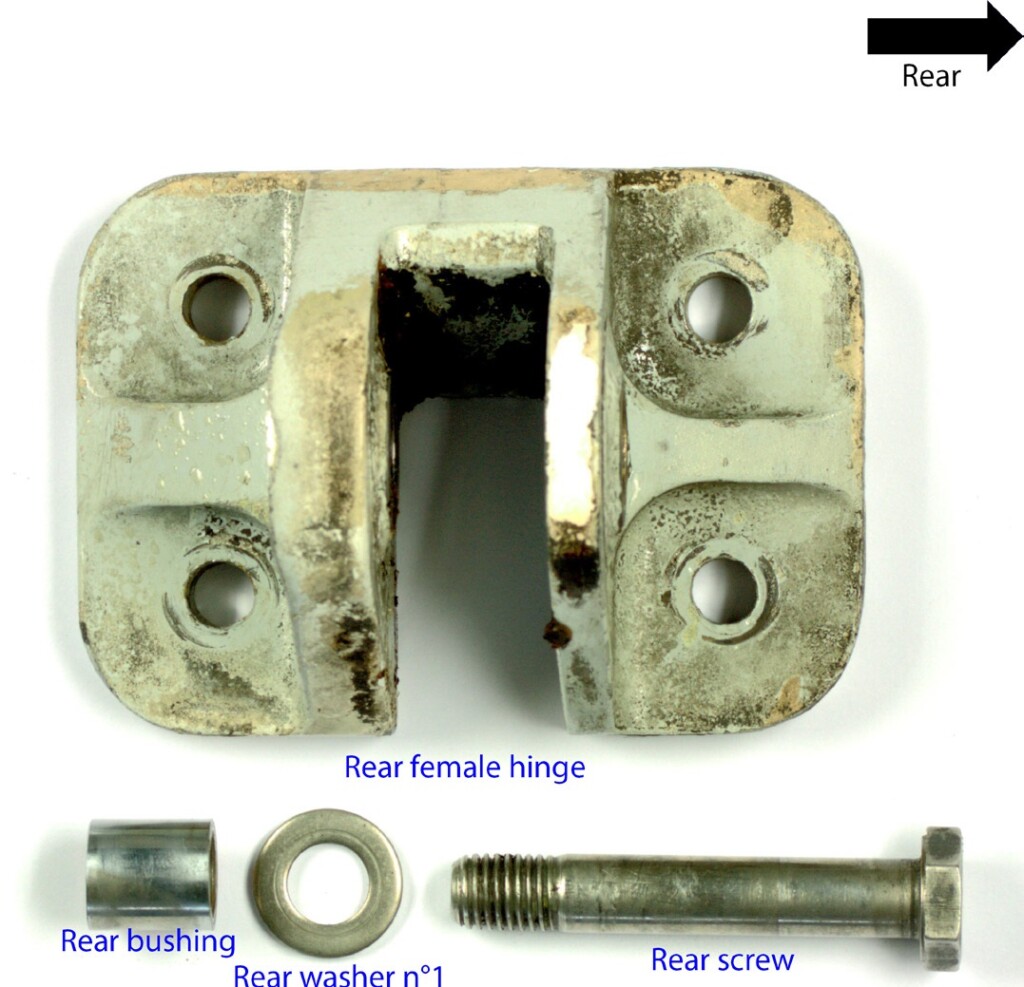

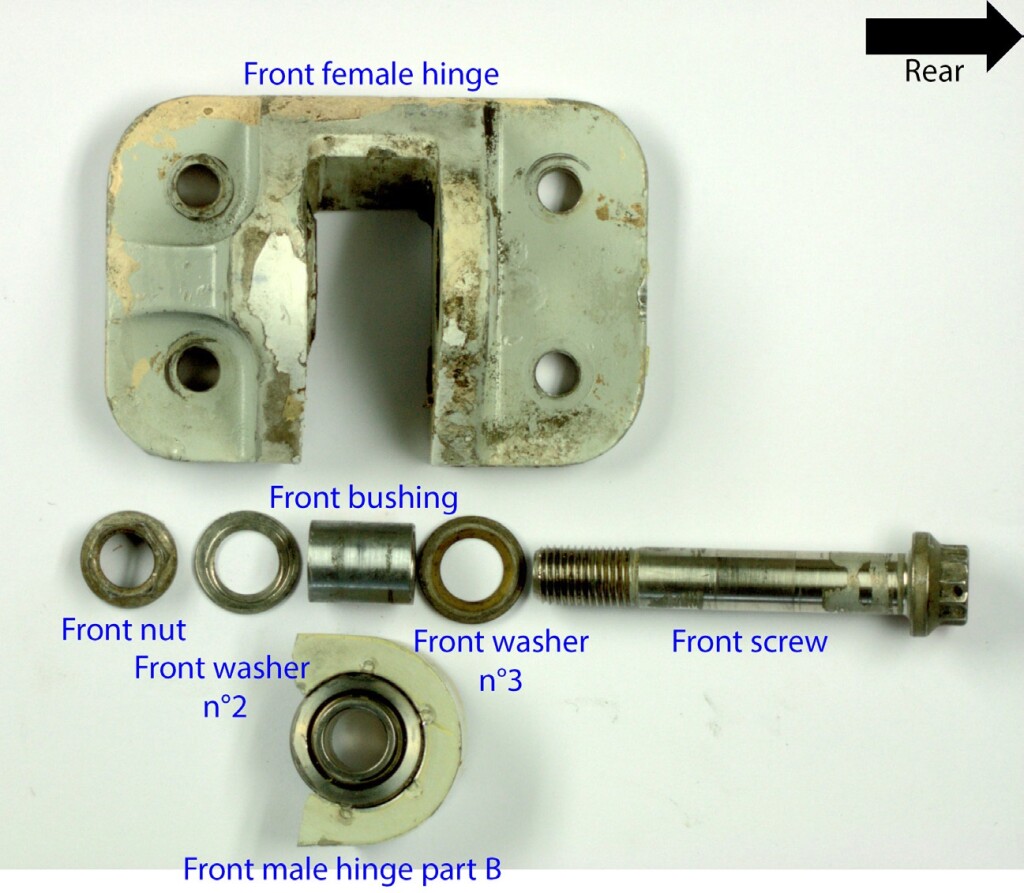
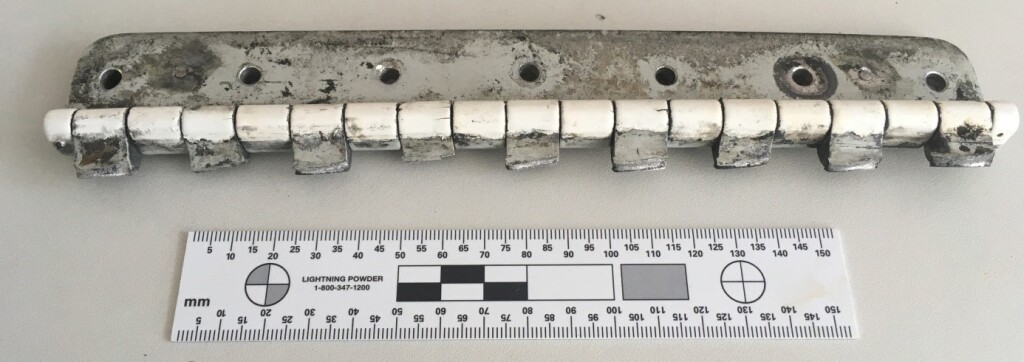


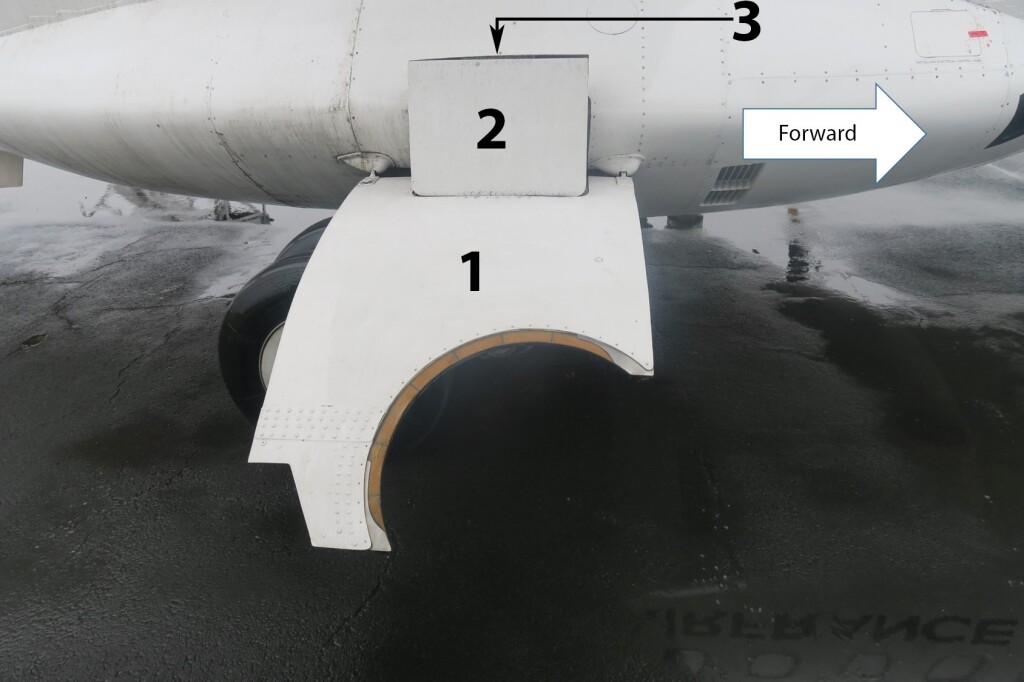


Recent Comments